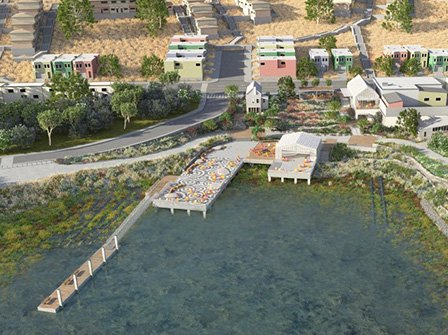San Francisco Cleans Up India Basin Waterfront Brownfield Site as Part of Greenspace Development Effort

San Francisco is working with a diverse group of community partners to develop a 13-mile corridor of greenspace with trails, parks and bayfront access along the city’s southern waterfront.
The Blue Greenway will include the India Basin Waterfront Park, an area with continuous waterfront access, including a former boatyard, also known as a brownfieldWith certain legal exclusions and additions, the term "brownfield site" means real property, the expansion, redevelopment, or reuse of which may be complicated by the presence or potential presence of a hazardous substance, pollutant, or contaminant., that must be cleaned up before park construction can begin. This project is vulnerable to a range of hazards and impacts, particularly sea-level rise.
The San Francisco Parks Alliance, San Francisco Department of the Environment and San Francisco Recreation and Parks Department received Brownfields grants and technical assistance from EPA to evaluate, assess and cleanup the former boatyard and Shipwright’s cottage on the property. The initial property assessment considered the vulnerability of the brownfield property to hazards and impacts from sea-level rise and shoreline alteration. The data used were based upon the San Francisco Bay Conservation and Development Commission’s Living with a Rising Bay: Vulnerability and Adaptation report.
The City of San Francisco decided to purchase a brownfield property within the India Basin to support development of the India Basin Waterfront Park. After purchasing the property, the City of San Francisco:
- Remediated the brownfield and contaminated in-water sediment.
- Created much needed open space for the community.
- Softened the shoreline to accommodate sea-level rise.
Contamination from prior boatyard activities extended from the uplands into the shallows. Because Brownfields resources can only be spent in upland areas, other funding from EPA’s San Francisco Bay Water Quality Improvement Fund was obtained to cover the costs of the subtidal contaminated sediment removal. The removal of contaminated sediment also prepared the site for future restoration.
Additionally, San Francisco collaborated with the Trust for Public Land to conduct the India Basin Waterfront Study. This study provides a community-supported vision for development of parkland throughout the India Basin waterfront that explicitly accounts for sea-level rise. The results of this study, and extensive stakeholder input, have led to the selection of a master plan through a design competition.
| How Did They Do It? | Applicable EPA Tools |
|---|---|
Identified Potential Hazards and Impacts.
| For additional information on conducting a vulnerability analysis, see U.S. Climate Resilience Toolkit |
Determined Site Vulnerability.
Design elements incorporate green infrastructure, including shoreline softening. | Use the EPA's Analysis of Brownfields Cleanup Alternative checklist to help consider anticipated risks from changing environmental conditions in your Corrective Action Plan. |
Received Brownfields Funds to Assess and Cleanup Property and Conduct Community Outreach.
| Learn more about how EPA’s Brownfields competitive grant funding for brownfields assessment, cleanup, revolving loans, and environmental training can be used to support preparedness and resilience for brownfields properties. |
Conducted More Specific Coastal Processes and Sea-Level Rise Analyses
| Use EPA’s Storm Surge Inundation Map to visualize the current 100 and 500-year flood zones in your area. To incorporate future projections, use the Climate Resilience Evaluation and Awareness Tool – Climate Scenarios Projection Map to identify projected scenarios for sea-level rise and other potential hazards and impacts. |
Similar Cases and More Information
San Francisco India Basin Waterfront project actively anticipated the effects of sea-level rise within their brownfield redevelopment efforts. To see how another community anticipated threats from increased precipitation events, see Barre City, Vermont. To see an example of how a Superfund waste site has prepared for changes in environmental conditions, see American Cyanamid Superfund case.
- Barre City, Vermont Accounts for Changing Environmental Conditions within a Brownfield Redevelopment Plan
- American Cyanamid Superfund Site Reduces Risk Exposure
References
The following links exit the site:
- Analysis of Brownfield Cleanup Alternatives (2013)
- India Basin Waterfront Parks Project, Coastal Process Study (2015)
- India Basin Waterfront Study Part 1 (2015)
- India Basin Waterfront Study Part 2 (2015)
- Guidance for Incorporating Sea Level Rise into Capital Planning in San Francisco: Assessing Vulnerability and Risk to Support Adaptation (2015)
- Living with a Rising Bay: Vulnerability and Adaptation in San Francisco Bay and on its Shoreline (2011)

